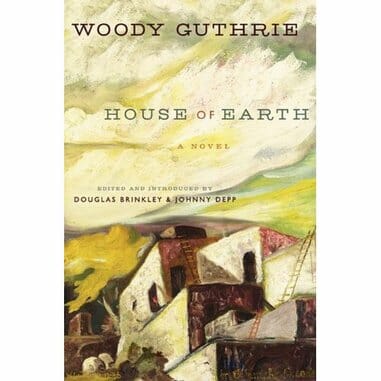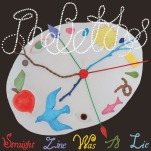House of Earth by Woody Guthrie
This machine builds adobes

Woody Guthrie has been dead for nearly 46 years, yet in February he published his first novel, House of Earth. Well, to be specific, Johnny Depp published it for him as the debut novel on Depp’s new imprint at Harper. Nonetheless, Guthrie is officially an author, complete with a back-cover photo. He’s probably singing “Dust Can’t Kill Me” in his grave right now.
The novel follows a hard-up farming couple, Tike and Ella Hamlin, struggling to survive the Dust Bowl of the 1930s on the plains of West Texas. The time and place render the Hamlins as much exposed to the hands of greedy landowners as to the brutal elements that continually plague their ramshackle home.
A burningly impassioned lovemaking scene opens the novel, immediately revealing the depth of Tike and Ella’s connection to each other as well as their ardent ties to the land. (If only its fertility mirrored theirs.) For Tike, who transparently serves as Guthrie’s mouthpiece, only one thing seems available of protecting them from both the forces of Mother Nature and capitalism:
Adobe.
Adobe structures, Tike convinces us, would be cheap to build, weatherproof, forever repairable with dirt and water, and—most importantly—100 percent owned by their tenants. Gone would be the terrifying threat of losing home.
When Guthrie finished writing his book in 1947, he only showed the full manuscript to one person, a filmmaker named Irving Lerner. Guthrie hoped that Lerner would make it into a feature film that showed Americans how they could counter the impoverishing woes of the Dust Bowl by building adobes. Lerner never made the film … and House of Earth eventually faded into obscurity.
Last July archivists dug a typescript of the novel, like a jug from Pompeii, out of the McFarlin Library at the University of Tulsa. If this makes House of Earth sound anything like an artifact, well, that’s because it is.
The word artifact comes from two Latin words: arte (ars), “skill,” and factum (facere), “to make.” The term conjures tools, urns, jewelry, gifts for the afterlife, hair combs. With the rare exceptions (think China’s Terracotta Warriors), artifacts generally come small in size and low in level of importance, nifty though they may appear. Their real magnitude can be measured in glimpses, the small insights they give into the lives of their makers and users. Think of artifacts as diaries you read piecemeal until the full set of entries forms a narrative.
After reading a government pamphlet about how adobe structures could be built for nothing and weather anything, Guthrie religiously adopted the mud-and-straw structures as a path not only to survival but to prosperity. Circa the Dust Bowl, an owner could obtain a plot of land for about $300. Considering the construction materials needed for adobe buildings, that would be about the only cost. No more rent. No more money spent on wood to repair walls that would eventually rot or fall to termites. No more faceless landlords fattening on the struggles of the poor.
-

-

-

-

-

-

-

-

-

-

-

-

-

-

-

-

-

-

-

-

-

-

-

-

-

-

-

-

-

-

-

-

-

-

-

-

-

-

-

-








































